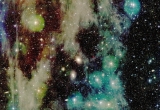An unexpected use of a large optical telescope: imaging the small scale structure of the diffuse interstellar medium
By combining multi-wavelength data obtained from space with Planck and WISE, and from the ground with MegaCam on the CFHT, a team of researchers has revealed the structure of the diffuse interstellar medium over several square degrees with unprecedented details. In particular, this study reveals the statistical properties of interstellar turbulence over a wide range of scales, from 0.01 to 10 pc.
The main innovation of this work is the use of a large optical telescope (the CHFT) to study the structure of the interstellar medium at high resolution and on a large area on the sky, something that is very challenging to obtain with more classical observations done in the infrared. This mapping of these interstellar cirrus clouds located within a few hundred parsec from the Sun can be done because interstellar dust grains scatter starlight. This scattered light has been detected for decades by optical telescopes. Here it is the first time that is exploited scientifically to study the structure of interstellar clouds which is composed of faint filametary structures of various sizes. The result obtained benefit from specific image processing and data acquisition techniques developped in the context of the MATLAS Large Program of the CHFT that aims at detecting faint diffuse emission around galaxies.
One advantage of the high angular resolution provided by the CFHT data is to eventually reach the angular scale at whcih turbulent energy dissipates. Understanding the exact process by which kinetic energy is dissipated and heat the gas is essential as it is key in the formation of dense structures that lead to the formation of stars. For instance, recent studies based on Herschel observations of molecular clouds have revealed the presence of filaments with width of 0.1 pc that seem constant whatever their mass. This observational fact has been attributed to the energy dissipation process, namely the ambipolar diffusion (friction between neutrals and ions). The present study is showing that the dissipation scale in the interstellar medium is smaller than 0.01 pc which brings important constraints on the exact process resposible for this dissipation.
These results are emphasizing the fact that scattered light from cirrus, an important source of pollution for deep imaging destined to mapping diffuse structures around massive galaxies, is carrying potentially precious information about the nature of the physical processes involved in the evolution of matter in our own galaxy.
More information: http://www.ias.u-psud.fr/pperso/mmiville/ATLAS/news_en_long.html
Scientific paper: M.-A. Miville-Deschênes, P.-A. Duc, F. Marleau, J.-C. Cuillandre, P. Didelon, S. Gwyn, E. Karabal, Probing interstellar turbulence in cirrus with deep optical imaging: no sign of energy dissipation at 0.01 pc scale, A&A, in press
Contact at IAS: Marc-Antoine Miville-Deschênes, mamd@ias.u-psud.fr
Optical image in real colours of the cirrus field obtained with MegaCam on the CFHT.
[[{"type":"media","view_mode":"media_responsive","fid":"533","attributes":{"alt":"","class":"media-image","typeof":"foaf:Image","width":"720"}}]]




